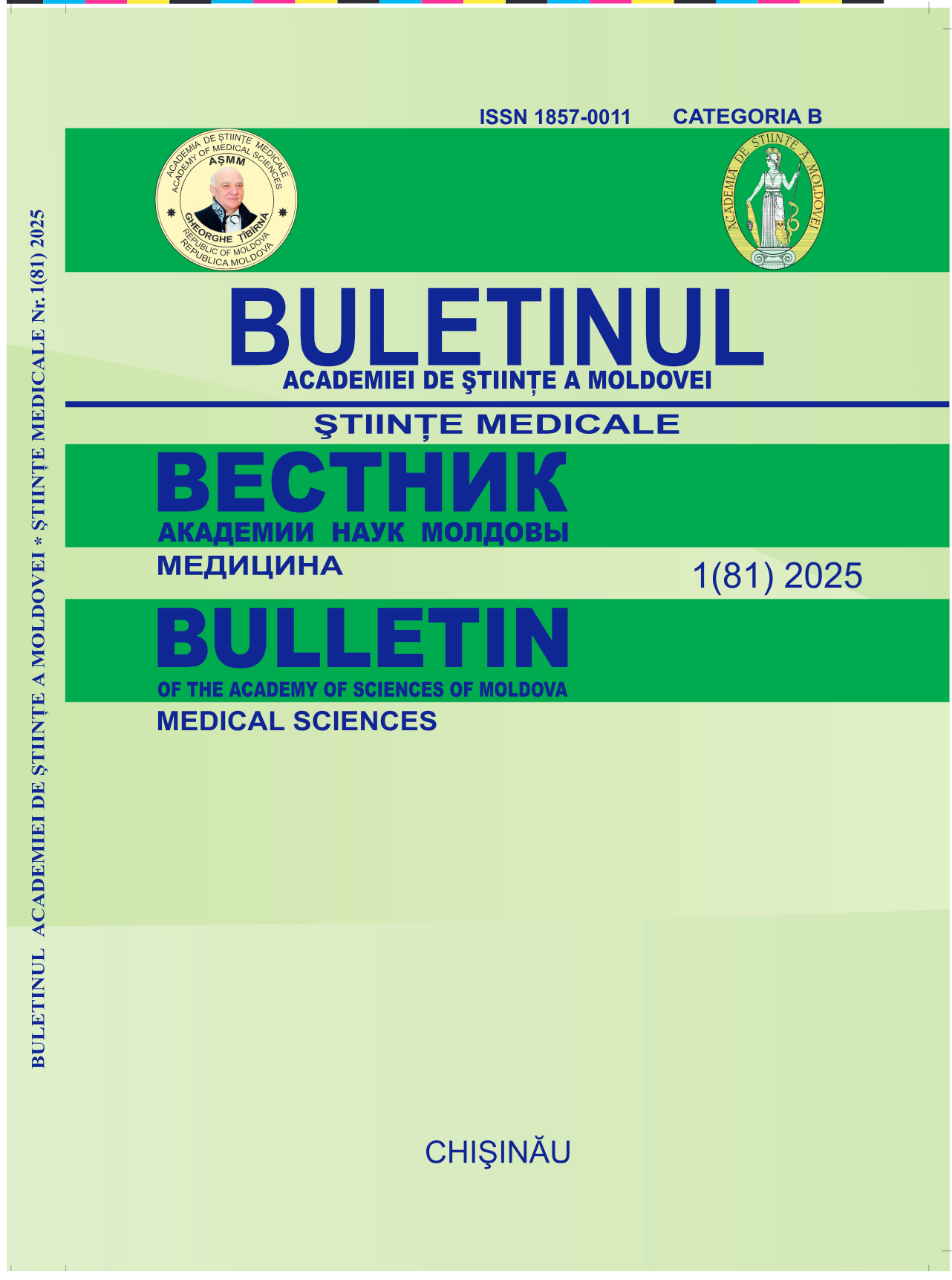Rate, clinical and management characteristics of patients with chronic non-obstructive coronary artery disease (NOCAD)
DOI:
https://doi.org/10.52692/1857-0011.2025.1-81.05Keywords:
non-obstructive CAD rate, coronary functional testingAbstract
Purpose: To assess the rate of non-obstructive CAD among patients with stable coronary artery disease and to evaluate the clinical, diagnostic and treatment features of this population. Material and Methods: The operative protocols and medical records of 3,200 patients who underwent coronary angiography in two cardiac catheterization centers in Moldova between January 1 and August 1, 2024, were analyzed to determine the rate of non-obstructive CAD. Clinical, demographic, diagnostic, and treatment data were collected from 200 consecutive patients with non-obstructive CAD. Results: The calculated rate of non-obstructive CAD was 43.4%, with a female predominance of 61%. The mean age of patients was 64.7±8.8 years. The most common risk factors were hypertension (87%) and dyslipidemia (73%), while diabetes mellitus was diagnosed in 26%. Only 47% of patients reported typical angina pain, and just 23% had objective evidence of ischemic changes on non-invasive testing. Microvascular angina was diagnosed in 69% of cases, and vasospastic angina in 6%. Antianginal treatment included beta-blockers (69%), calcium channel blockers (52%), nitrates (4%), and trimetazidine (8%). Baseline therapy included ACE inhibitors (77%), statins (72%) and antiplatelets (49%). Conclusions: The rate of non-obstructive CAD evaluated in two PCI centers in Moldova was 43.4%, with a predominance of women accounting for 61%. The diagnosis of non-obstructive CAD presents a challenge for clinicians due to the atypical clinical presentation (typical anginal pain in only 47% of cases), non-informative non-invasive tests (objective evidence of ischemic changes detected non-invasively in 23% of cases), and the unavailability of invasive coronary testing.
References
Wang H, Naghavi M, Allen C, Barber RM, Carter A, Casey DC, et al. Global, regional, and national life expectancy, all-cause mortality, and cause-specific mortality for 249 causes of death, 1980–2015: a systematic analysis for the Global Burden of Disease Study 2015. Lancet . 2016;8;388(10053):1459–544.
Cook S, Walker A, Hügli O, Togni M, Meier B. Percutaneous coronary interventions in Europe: Prevalence, numerical estimates, and projections based on data up to 2004. Clin Res Cardiol . 2007;26;96(6):375–82.
Patel MR, Peterson ED, Dai D, Brennan JM, Redberg RF, Anderson HV, et al. Low Diagnostic Yield of Elective Coronary Angiography. N Engl J Med. 2010; 11;362(10):886–95.
Ong P, Camici PG, Beltrame JF, Crea F, Shimokawa H, Sechtem U, et al. International standardization of diagnostic criteria for microvascular angina ⁕. 2017;
Vrints C, Andreotti F, Koskinas KC, Rossello X, Adamo M, Ainslie J, et al. 2024 ESC Guidelines for the management of chronic coronary syndromes. Eur Heart J. 2024;29;
Kunadian V, Chieffo A, Camici PG, Berry C, Escaned J, Maas AHEM, et al. An EAPCI expert consensus document on ischaemia with non-obstructive coronary arteries in collaboration with european society of cardiology working group on coronary pathophysiology & microcirculation endorsed by coronary vasomotor disorders international. EuroIntervention. 2021;16(13):1049–69.
Jespersen L, Hvelplund A, Abildstrøm SZ, Pedersen F, Galatius S, Madsen JK, et al. Stable angina pectoris with no obstructive coronary artery disease is associated with increased risks of major adverse cardiovascular events. Eur Heart J. 2012;33(6):734–44.
Tavella R, Cutri N, Tucker G, Adams R, Spertus J, Beltrame JF. Natural history of patients with insignificant coronary artery disease. Eur Hear J - Qual Care Clin Outcomes . 2016:1;2(2):117–24.
Nicholls SJ, Wang Z, Koeth R, Levison B, Delfraino B, Dzavik V, et al. Metabolic profiling of arginine and nitric oxide pathways predicts hemodynamic abnormalities and mortality in patients with cardiogenic shock after acute myocardial infarction. Circulation. 2007;116(20):2315–24.
Maddox TM, Stanislawski MA, Grunwald GK, Bradley SM, Ho ; P Michael, Tsai TT, et al. Nonobstructive Coronary Artery Disease and Risk of Myocardial Infarction. JAMA . 2014;312(17):1754–63.
Sharaf B, Wood T, Shaw L, Johnson BD, Kelsey S, Anderson RD, et al. Adverse outcomes among women presenting with signs and symptoms of ischemia and no obstructive coronary artery disease: Findings from the National Heart, Lung, and Blood Institute– sponsored Women’s Ischemia Syndrome Evaluation (WISE) angiographic core laboratory. Am Heart J. 2013;166(1):134–41.
Crea F, Camici PG, Merz CNB. Coronary microvascular dysfunction: an update. Eur Heart J . 2014; 1;35(17):1101–11.
Beltrame JF, Crea F, Kaski JC, Ogawa H, Ong P, Sechtem U, et al. International standardization of diagnostic criteria for vasospastic angina. Eur Heart J. 2017;38(33):2565–8.
Ong P, Camici PG, Beltrame JF, Crea F, Shimokawa H, Sechtem U, et al. International standardization of diagnostic criteria for microvascular angina. Int J Cardiol. 2018;250:16–20.
Ford TJ, Stanley B, Sidik N, Good R, Rocchiccioli P, McEntegart M, et al. 1-Year Outcomes of Angina Management Guided by Invasive Coronary Function Testing (CorMicA). Cardiovasc Interv. 2020;13;13(1):33–45.
Ford TJ, Berry C. How to diagnose and manage angina without obstructive coronary artery disease: Lessons from the British heart foundation CorMicA trial. Interv Cardiol Rev Res Resour. 2019;14(2):76–82.
Virani SS, Newby LK, Arnold S V., Bittner V, Brewer LPC, Demeter SH, et al. 2023 AHA/ACC/ACCP/ ASPC/NLA/PCNA Guideline for the Management of Patients With Chronic Coronary Disease: A Report of the American Heart Association/American College of Cardiology Joint Committee on Clinical Practice Guidelines. J Am Coll Cardiol. 2023;82(9):833–955.
Downloads
Published
License
Copyright (c) 2025 Bulletin of the Academy of Sciences of Moldova. Medical Sciences

This work is licensed under a Creative Commons Attribution 4.0 International License.



